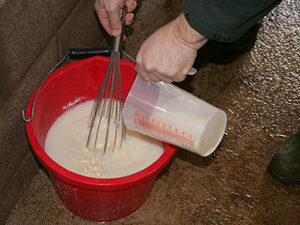Rules Of Colostrum For Lambs
16 August 2016The basics – colostrum is an essential element of preventing lamb mortality. It is a super food which provides energy and nutrients, helps to maintain body temperature, and allows for antibodies which form the lamb’s passive immune system as well as being a laxative cleaning out the digestive tract of the new born lamb. At birth lambs do not have antibodies, because the antibodies in the ewe’s blood stream do not cross the placenta.

It is extremely important to ration the in-lamb ewe appropriately to ensure the production of good quality colostrum is stimulated. Rations should be tailor made to the quality of forage that is being offered to the ewe.
Most lambs will suckle themselves without assistance, but this must be monitored to ensure adequate amounts are being ingested. After lambing it is a good idea to strip the teat, to check for the quality and quantity of colostrum, this also gives you the added benefit of removing the wax plug from the teat. If lambing ewe lambs, crutching is good practice to allow the lamb easy access to the teat. Every effort should be made to ensure the ewe nurses the lamb, however some may be born in multiples, have large or misshapen teats, poor yield, and infection such as mastitis or orf on the teat or be orphaned and need help. It is essential that this help is given in the first few hours of life and then little and often following this. Lambs should receive 50ml/kg of liveweight colostrum in the first few hours of birth and by the time the lamb is 24 hours old it should have received 200ml/kg.
Adequate ewe colostrum is the best start a lamb can get but, if for some reason it is not available, there are other options such as powdered substitutes and cow’s colostrum. If any ewe has excess colostrum this can be milked out, measured and frozen in ice cube trays or freezer bags. But beware when heating or thawing frozen supplies do not denature the protein based immunoglobulins with extreme heats. As a guide if the water is too hot for your hand then it is too hot for colostrum. It should be heated to 39°C. If feeding ewes milk through a tube or teat you may need to mix with warm water to ensure it easily flows through the duct. Cow colostrum is often available from dairies but it is not as concentrated as ewe colostrum, the quantity fed should be increased by approximately 30% to ensure for adequate antibodies. Johne’s can be transmitted through milk, so ensure the colostrum is sourced from a Johne’s free herd.
Key Rules
- The 3 Qs – Quality, Quantity, Quickly
- 50ml/kg of liveweight in the first few hours
- 200ml/kg of liveweight in the first 24 hours
- If not adequate supply, quality or quantity substitute with other ewes colostrum, powder or cows colostrum
- Beware when defrosting or heating supplies not to denature protein. If too hot for your hand then too hot for colostrum
- Ensure cow colostrum is from a Johne’s free herd and increase quantity to allow for the quality.
Kirsten Williams, kirsten.williams@sac.co.uk
Related Materials
Sign up to the FAS newsletter
Receive updates on news, events and publications from Scotland’s Farm Advisory Service
